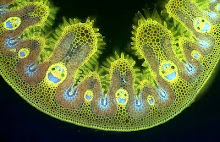If you are looking for a plant that has good credentials for inclusion in a wildlife garden, then soapwort Saponaria officinalis comes close to being a strong candidate - but with one serious drawback. In my experience its rapidly-elongating rhizomes make it very invasive.
Back in 1999 a trial of 25 native plant species carried out at the University Botanic Garden at Cambridge ranked soapwort was the second most popular nectar source for butterfly species, with a very high nectar secretion rate and second only to purple loosestrife Lythrum salicaria in the number of butterfly species that it attracted. Not only that - it's also virtually slug-proof. Recently researchers in Poland have shown that slugs avoid eating soapwort.
Soapwort's slug-deterrent properties are due to compounds called saponins in its rhizomes and leaves. Shred some leaves, pour boiling water over them, give the resulting extract a good shake in sealed jam jar and you get this lovely frothy lather. Saponins are natural detergents, found in many plants including horse chestnut seed ('conkers'). A few years ago some Austrian research showed that slugs will not cross a barrier of ground-up conker seed meal and theoretically sprayed saponin extracts have the potential to protect seedlings that are susceptible to slug damage, but for the fact that saponins are very soluble and wash away in the rain.
Saponins are also present in quinoa Chenopodium quinoa seeds, a popular high protein grain with an excellent amino acid balance, sold in vegetarian and health food stores. They illustrate one of the great paradoxes of crop domestication, which often removes plants' natural defences and then must find alternative means for protecting crops from pests.
Quinoa is a very ancient crop from the Andes and the seeds need to be soaked in a couple of changes of water to remove the soluble saponins, which are mildly toxic to humans. Most quinoa seeds marketed for human consumption today should have been pre-washed but anyone growing it (quinoa can be cultivated in the UK - the above trial crop was photographed in Durham) should be careful to soak the seeds in at least two changes of water before consumption. In the wild the bitter saponins are natural bird deterrents, so birds tend to leave those easily accessible, exposed seeds heads alone but attempts to breed more palatable saponing-free quinoa have produced crops that are rapidly devasted by birds. As is the case with many domesticated food crops, there is a conflict between breeding cultivars to remove anti-nutritional defensive compounds and protecting crops from pests. In order to make many crops edible for humans we need to weaken their natural chemical defenses and then must resort to alternative pesticides of one kind or another to combat the pests and diseases that inevitably attack: such is the treadmill of agriculture.
Soapwort's saponins have been used for washing people and clothes for centuries. By all accounts an extract in hot water makes a fine shampoo, although I have to say that the extract smells like boiled cabbage so you'd need to rinse your hair very well afterwards and maybe scent the water with rosemary (as my grandmother used to do when she washed her hair). Soapwort extracts are also still used by conservators as gentle detergents to cleanse delicate fabrics and are reported to have been used to clean the Bayeaux tapestry.
You can read an interesting article about the origin of soaps, including saponins from soapwort here.
















